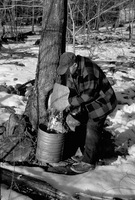 | Back to e-WV
| Back to e-WV
 The West Virginia Encyclopedia
The West Virginia Encyclopedia
 | Back to e-WV
| Back to e-WV
 The West Virginia Encyclopedia
The West Virginia Encyclopedia

Maple syrup is made from the sap of several species of maple, but primarily sugar maple. The production of maple syrup in West Virginia is largely limited to the northern high country where sugar maples thrive. Maple sap production occurs on warm days following freezing nights. During the late winter harvest, sugar camps and sugar houses are the focal points of production. Others make syrup on a smaller scale, and some farmers lease out their trees or sell sap to larger syrup producers. In 2002, 57 farms produced maple sap in West Virginia, and 2,857 gallons of syrup was produced. By 2007, the number of farms had increased but production had declined. In 2016, the West Virginia Maple Syrup Producers Association was created, and in 2017 the state received a three-year Access and Development grant from the United States Department of Agriculture. Both helped the industry grow in the state. By 2022, production had risen to 11,000 gallons of syrup and 69,000 tapped trees. According to the West Virginia Maple Syrup Producers Association, the state has more than 50 commercial producers. Tyler, Preston, and Pendleton counties lead the state in syrup production.
The sugar water harvest lasts about six weeks, usually in February and March, and as the season progresses the sap becomes darker in color and stronger in flavor. When the sap is rising, it flows freely when the trunk is tapped. The favored method is to drill holes into which spiles are inserted. Spiles are spouts that conduct sap. Once buckets were hung under the spiles and collected manually, but nowadays commercial producers connect the spiles to plastic tubes that run in elaborate networks to collecting tanks. Once gathered, water is removed from the sap by reverse osmosis at the commercial operations, followed by evaporation. Reverse osmosis is a technical process, while evaporation is done the old-fashioned way, by boiling. Forty to 50 gallons of sap is required to make one gallon of syrup. If boiling continues long enough, the syrup turns to maple sugar. Once the syrup is ready, producers grade, date, bottle, and ship the product.
The basic process of making maple syrup from sugar trees has not changed in centuries. Indians once chipped gashes in maple trees and inserted reeds to catch the sap, which they boiled down over a fire. Today, hobby syrup makers drill holes, hammer spiles, hang buckets, collect sap, and evaporate water over an outdoor fire or in the kitchen.
Written by Mark F. Sohn
Hauser, Susan Carol. Sugartime: The Hidden Pleasure of Making Maple Syrup. New York: Lyons Press, 1997.
Lawrence, James M. & Rux Martin. Sweet Maple: Life, Lore and Recipes from the Sugarbush. Montpelier: Vermont Life/Chapters, 1993.
Sutton, Mary Lee. Sweet Pickens: Looking Back at Maple Harvest Time. Goldenseal, (Spring 1988).